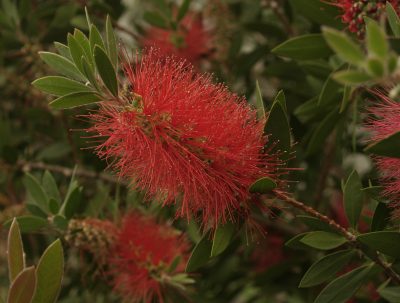Bottlebrush
Callistemon rigidus

There are lots of different species, varieties, and cultivars of bottlebrush, an Australian native, so do a little research on the differences before you buy.
The two most important distinguishing characteristics are size and hardiness, since dwarf cultivars and more cold tolerant species are becoming more widely available.
Bottlebrush is a small, usually shrubby tree, normally getting only 10 to 15 feet tall. Bees absolutely love the fuzzy red flowers and the tree will be buzzing with life all summer long.
This tree is notoriously frost sensitive, usually being completely killed if temperatures get into the 20s. But I’ve also seen bottlebrush taken out by our extreme Texas heat during abnormally hot, dry summers.
One way to protect bottlebrush from the heat is to plant it in a sheltered spot, with maybe only 6 to 8 hours of summer sun.
And the north side of a landscape should be avoided, since that’s the coldest spot. Local garden blogger Dr. Robin Mayfield shares her story of her beloved specimen. After the harsh summer of 2010, which was followed by an abnormally cold winter, her majestic 12 foot tree succumbed to the stress of such extreme weather, but she loved the tree so much, she’s decided to plant again this year, in a different spot in her yard.
Bottlebrush is evergreen, so it’s a good choice for screening out unsightly views. But since it’s wispy, it allows light to filter through, rather than creating a solid hedge-type feel, giving privacy without overwhelming an area.
Robin reports that her trees were very drought tolerant once they were established, and were very happy in her unamended heavy clay soil.
So, final analysis: lovely tree that brings on the bees for months in warm weather. But, it needs good drainage, sunlight but not searing, and we can lose them in cold winters.
categories:
